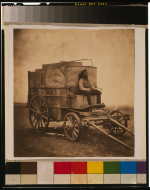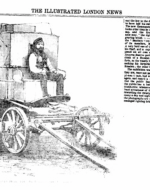Created by Peter Hoffenberg on Sun, 05/23/2021 - 13:36
Description:
Roger Fenton required a great deal of “baggage” to complete his photographic work, including during the months between March and June 1855 thirty-six large chests of equipment and his horse-drawn photographic van. That vehicle was not always easy to move about and could get quite heated from both the developing fluids and the outside temperature (Gernsheim, Masterpieces of Victorian Photography 100-101 and Fenton, “Narrative of a Photographic Trip” 289). The press and periodicals noticed Fenton’s van. Some at the time claimed that the Russians thought it was an ammunition Van, and thus they took aim at it. The Illustrated London News described the Van in its pages in early November, and provided an engraving adapted from one of Fenton’s onsite photographs (“Mr. Fenton’s Crimean Photographs” 557). Completing this common thread, the Illustrated London News thought that among the visitors “but few, perhaps, will be able to appreciate the difficulties under which Mr. Fenton, with rare skill and courage, succeeded in producing the admirable pictures.” It was as if the photographer were himself at war—heat, labor, technology and the danger of cannon balls and bullet adding value to the material image. Fenton added details, including “the plague of flies” (“Narrative of a Photographic Trip” 289). The second extended discussion in The Illustrated London News of the Crimean War photographs and exhibition also detailed the photographic process in the field, reducing the sense of natural magic and replacing it with a mechanical enchantment. “The unexampled interest as well as the extraordinary merit of the exhibition of photographs taken by Mr. Fenton in Crimea” had warranted a return to the subject for the paper (“Mr. Fenton’s Crimean War Photographs” 557).
That second article recounts Fenton’s movements with his “travelling van, or dark room, absolutely necessary for the purposes of taking these views and portraits” (“Mr. Fenton’s Crimean War Photographs,” 557). A steamer, difficult horse, Lord Raglan’s “extreme kindness” were all part of this travelogue to, through and from the war zone of the Crimea. The contributor claimed that Fenton was “frequently under fire” in Crimea, particularly during the three days it took to complete a pair of photos: “The Valley of the Shadow of Death” and “The Panorama of Inkerman.” “The Plateau of Sebastopol” was also a challenge, but the obstructions Fenton faced were less human and martial, and more environmental: the ground and the variation of the atmosphere. Again, though, struggle, challenges, persistence and work, but no mention of genius. Here was the heroic explorer and chronicler, as much, if not more than, the heroic artist. A bit later, Fenton would author and publish his own narrative of those challenges and how he overcame them (“Narrative of a Photographic Trip” 284-290).
Subject: Marcus Sparling, full-length portrait, seated on Roger Fenton's photographic van.
Medium: photographic print : salted paper ; 17.5 x 16.5 cm.
Call Number/Physical Location: PH - Fenton (R.), no. 122 (A size) [P&P], Library of Congress
Source Collection: Fenton, Roger, 1819-1869. Roger Fenton Crimean War photograph collection
Repository: Library of Congress Prints and Photographs Division Washington, D.C. 20540 USA http://hdl.loc.gov/loc.pnp/pp.print
Digital Id: cph 3g09240 //hdl.loc.gov/loc.pnp/cph.3g09240cph 3a06025 //hdl.loc.gov/loc.pnp/cph.3a06025
Library of Congress Control Number: 2001697111
Reproduction Number: LC-USZC4-9240 (color film copy transparency) LC-USZ62-2319 (b&w film copy neg.)
Rights Advisory: No known restrictions on publication.
LCCN Permalink: https://lccn.loc.gov/2001697111
Rights & Access: The contents of the Library of Congress Fenton Crimean War Photographs are in the public domain and are free to use and reuse. Credit Line: Library of Congress, Manuscript Division, Fenton Crimean War Photographs.
Works Cited
Fenton, Roger. “Narrative of a Photographic Trip to the Seat of War in the Crimea,” Journal of the Photographic Society 2:38 (21 January 1856): 284-291.
Gernsheim, Helmut. Masterpieces of Victorian Photography. London: Phaidon Press, 1951.
“Mr. Fenton’s Crimean Photographs.” Illustrated London News 10 November 1855: 557.
Copyright:
Associated Place(s)
Timeline of Events Associated with "The Artist's Van," by Roger Fenton (c. 1855)
Artist:
- Roger Fenton



